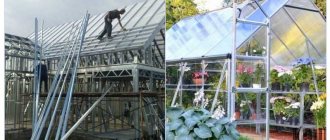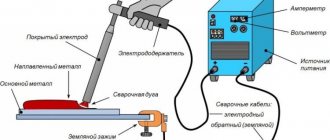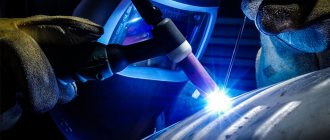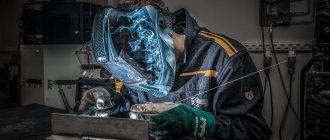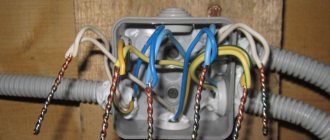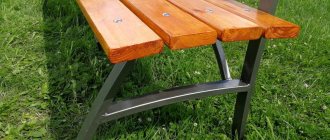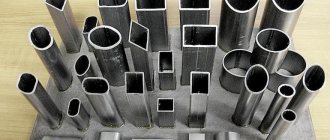Currently, profile pipes are often used for the production of lightweight frames, metal structures, fence structures, trusses, gates, frames for various purposes and other products.
Welded structures made from this material are lightweight and also have fairly high strength indicators. It is obtained from an ordinary pipe by plastic deformation, in a hot or cold state. The most commonly used profile has a square or rectangular cross-section. The vast majority of it is made from low-carbon steel.
Low-alloy and stainless steels are used on a much smaller scale, due to the high price of the resulting structure. For beginners, welding a profile pipe with an inverter is often a problem, especially if the wall thickness is 1.5-2 mm.
Welding mask
- This is the part of the welding equipment that you should not skimp on if you are going to be a skilled welder and preserve your vision. A good mask with a substitute will serve you for many years. The sales consultant in the store will help you with the right choice. It's better to pay a little more and get the Maxa Chameleon, which automatically dims. This is convenient; you can see where the electrode is before welding begins. A regular mask with a dark glass filter will not provide this opportunity. Another advantage of the chameleon is that you can beat off slag without a shield. The mask itself will be used instead.
When performing welding work, you will need auxiliary tools and materials
:
Types of welding used for profile pipes.
Profile pipe is used in the production of metal frames and structures made of low-carbon steel. Profile sizes according to GOST are from 10-15 mm to 180-230 mm, and thicknesses are from 0.8-1.0 mm to 18-20 mm.
What is the best way to weld a profile pipe? To answer this question, you need to understand how such products are generally cooked. The following methods are used for welding:
- Manual welding with consumable electrode;
- Semi-automatic in CO2;
- In an argon environment with a non-consumable electrode.
The latter type is used for profiles of small thickness (usually up to 1.5 - 2.0 mm). For a small amount of work, these profiles are welded using manual arc welding using an inverter with stick electrodes.
This method is convenient, the equipment is not expensive, and the process does not cause much difficulty. In this article on the website mrmetall.ru we will reveal in detail the technology of manual welding with an inverter of structures made of this material.
Semi-automatic (mechanized) welding of profile pipes is used in the production of dimensional welded structures in production. The undoubted advantage of this method is the possibility of carrying out the process at small thicknesses and minimal heat input, which reduces the resulting deformations by an order of magnitude. This is especially true for long seams. Almost anyone can carry out the process semi-automatically, since the process is automated. Read about what you need for this in our article.
Of course, there is also a drawback in the form of difficulty in applying this method in installation conditions, due to the gas protection being blown away by gusts of wind. This leads to the occurrence of defects and unstable process flow.
Argon welding is rarely used for this type of structure due to its high cost. Inert gas is expensive, and the method has low productivity. It is used in cases where it is necessary to weld stainless steel products or profiles of very small thickness, then the use of this method is justified and irreplaceable.
Basics of welding corrugated pipes
Profiled pipes are produced with walls of different thicknesses. At the same time, it is most difficult to work with thin-walled rolled metal. To perform the welding process efficiently, you need to have knowledge and experience. Therefore, it is necessary to understand how thin-walled pipes are welded. During this process:
- current used is 10-60 A;
- electrodes with a diameter of 0.5-2 mm are used;
- Only one pass of the electrode is carried out at the junction of the parts.
Welding speed affects the quality of the seam. The process must be completed before the edges of the two workpieces being joined cool down.
Important! Rutile electrodes allow for pull-out welding.
Electrodes with rutile coating Source temir.ru
To make quality connections, you also need to know how to properly weld a profile pipe, regardless of the wall thickness. When carrying out such welding work, it is necessary to take into account that during the process the metal melts and often fills or even completely covers the internal space of the pipe. If it is necessary to maintain the hollowness of the corrugated pipes, it is necessary to ensure that drops do not fall into the internal cavities of the parts being welded.
In addition, profiled pipes are more deformed when exposed to high temperatures compared to similar round products. It is also necessary to ensure the correct formation of the weld bead and evenly heat the metal while making end connections to prevent the appearance of high stress in the corners.
How to weld a profile pipe with an inverter.
We will answer this question within the article. The information in the article will be aimed at novice welders and beginners. It is quite simple to weld a profile pipe with an inverter; therefore, welding using this method is used almost everywhere. The first thing to do is prepare the edges.
The first thing to do is clean the metal. You can clean it with a grinder, wire brush or file. This surface treatment will significantly improve the result. Rust, scale, oil, dust and other contaminants must be completely removed. It is advisable to degrease the surface.
Then you need to measure the thickness of the base metal. This will determine the further preparation and processing of the product, the technique and modes in which welding will be performed. With a thickness of 1.5 mm to 3.5-4.0 mm, the process can be carried out without cutting edges. With a thickness of about 3 mm, it is better to use edge cutting to ensure complete penetration.
Polarity is reverse (“+” - on the electrode; “-” - to the product). You can read more about polarity here.
Welding methods
You should determine in advance which electrodes and how to weld the profile pipe. There are several methods for joining workpieces by welding, each of them has its own characteristics, which determine the choice of pipe joining option.
Manual arc welding
One of the simplest methods to get an even seam. A transformer or inverter welding machine is suitable for the job. Arc welding is suitable for connecting profiles with different wall thicknesses and section sizes. If the thickness is more than 4 mm , then the edges of the workpiece are protected and degreased.
diameter of 2.3 mm are needed; the current on the device is set in the range from 50 to 60 A. The arc method allows welding horizontally, vertically and even from below.
Welding for beginners video
Features of electric welding
Welding is performed using non-consumable (tungsten) electrodes. The rod is placed at a short distance from the bath, this will allow the formation of a dense, continuous seam with a short arc.
The diameter of the electrode is selected based on the thickness of the profile. If its walls are no more than 2 mm thick, then a rod with a diameter of 1 mm will be required. If the workpieces to be connected are thicker, then it is better to take an electrode with a diameter of 1.6 mm. The filler wire is selected in a similar way, that is, it must match the thickness of the material being welded or be slightly thicker.
For electric welding you will need a transformer, an inverter, a power supply, and equipment for supplying shielding gas. The consumption of argon or other gas should be no more than 12 liters per minute, the current strength depends on the thickness of the profile and can be in the range of 50-120 A . You need to finish cooking by reducing the voltage. The gas is shut off 10-20 seconds after the current supply is stopped.
Gas welding
Welding using gas equipment is no different from other methods. The desired area is heated, after which filler wire is applied to it. Melting, the rod fills the joint. The rod is moved strictly in the direction of the joint; depending on the chosen method, two gas welding technologies are distinguished:
- From left to right . The additive moves behind the burner, so the working area is optimally heated. In this case, the welder can constantly monitor the process. This method is considered the most suitable when welding profiles with a thickness of 5 mm or more;
- From right to left . When choosing this method, workpieces burn out extremely rarely, but it is suitable for connecting only thin-walled profiles.
After the seams have cooled, it is advisable to clean them and coat them with an anti-corrosion agent.
Important! The edges of corrugated pipes with walls up to 4 mm thick should not be formed.
How to properly weld metal using gas welding video
Using resistance welding
More suitable for enterprises, as it requires the use of expensive equipment and is characterized by increased complexity. No filler materials are used during resistance welding. Welding of workpieces occurs under high pressure electrodes with simultaneous exposure to voltage at the joining point. This leads to the melting of the metal and the formation of a homogeneous medium, which turns into a monolith after cooling. That is, the resulting connection has the highest margin of safety.
Resistance welding video
Welding with inverter
A type of arc welding using an inverter welding machine. The inverter is suitable for welding profiles of different thicknesses. The operating mode of modern models is pulse. 2 mm thick profile pipe , you need a current of 50 to 60 A. Thick-walled rolled products are connected using a more powerful electric current.
The work uses a coated additive. When the arc is excited, it begins to burn, which leads to melting of the coating. Part of it goes into molten rolled metal and part of it is converted into gas. Due to this, the welding zone does not come into contact with air. Inverter machines ensure smooth and high-quality seams.
Welding inverter video
What electrodes are best for welding profile pipes 1.5 - 3 mm.
Welding electrodes are best used with rutile or basic coating. For beginners, in our opinion, the best electrodes are OK-46, OZS-12, MP-3, which contain rutile as a coating. It provides easy ignition and stable arcing. In order to properly weld the structure, it is necessary to pay special attention to assembly.
In most cases, structures are assembled using tacks. We place potholders along the edges of the parts to be joined. After tack welding, we adjust the welding current on the test part. These parameters vary for different brands of electrodes. On the packaging with electrodes, the manufacturer gives general recommendations and applies them, setting the current values.
The profile pipe can be welded together either end-to-end, overlapping, or at an angle of 90 degrees. Carrying out the process on a test part, we change the current parameter to achieve optimal weld geometry. The metal should not be burned, and the welding arc should burn steadily and be easily excited. For example, for MP-3 electrodes with a diameter of 2.5 - 3 mm. You can use a welding current in the region of 75-80 A.
Welding modes, welding current strength and joint dimensions must be taken from the technical sheet. If you need technical maps, you can write to us using the feedback form located at the very bottom of the page. We will send you technical maps specifically for your case by email.
The smaller the electrode diameter, the lower the current strength, and therefore the product will heat up less. When welding thin products, it is recommended to use electrodes as thin as possible so as not to burn through the metal.
What electrodes are used for profile welding
Profile pipes are most often made of carbon or low-alloy steel. The following electrodes are most suitable for welding:
- ANO-4 . Universal and most popular type of electrodes. Suitable for various types of devices, does not require pre-calcination;
- OZS-12 . Allows you to obtain a high quality seam. But electrodes of this brand are not characterized by increased moisture resistance;
- UONI-13/55 . The best electrodes for forming a strong connection;
- MR-3S . They are rarely used and mainly in situations where the quality of the seam must be ideal.
Which electrodes are preferable for welding a fence from a profile pipe? As practice shows, it is easier for beginners to use brands such as MP-3, OZS-12. They contain rutile, which simplifies the initial stage of welding, and the joints are strong and resistant to moisture.
Advice! The necessary skills can be obtained by practicing welding various pipe scraps.
How to weld a profile pipe so as not to burn it.
After completing the preparation, we begin to cook our product. With a part thickness of 1.5 mm, it is necessary to start on a tack so as not to burn through the thin metal.
Let's consider the correct sequence of how to butt weld thin-walled parts from a profile pipe:
- We light an arc on the tack;
- We move along the joint for a distance of about 10 - 15 mm at an angle backwards without oscillatory movements and return;
- We make the arc as short as possible so that the end of the electrode moves away from the melt of the weld pool by no more than 1.5 mm. This will provide better protection for the weld pool. When the process takes place on a short arc, the voltage decreases, resulting in a reduced temperature of the molten metal. This is exactly how you need to weld a profile pipe so that it doesn’t leak.
- When approaching the end of the joint, you cannot simply break the arc. It is necessary to return 20 millimeters to the weld metal and break the arc there. If this is not done, there will be a crater at the end of the seam.
- We beat off the slag and remove metal splashes.
Using potholders.
If you are a novice welder, then it is better for you to weld a profile pipe with an inverter using additional tacks. They need to be made not only along the edges, but also one potholder in the middle.
As already mentioned, it is better to use electrodes as thin as possible: 2.0 - 2.5 mm. If your hand shakes during the process and the arc height fluctuates, hold the electrode with the index finger of your left hand. This is how you can gradually learn to cook.
For beginner welders, there are very useful videos at the end of the article, watch them. Another way to avoid burning your profile. If the metal still burns through, there is a life hack for you. It is necessary to install a rectangle or square of metal into the pipe, suitable in cross-section. For example, for a 20x40 profile, you can take rectangular metal 15x35.
After this, you need to dock the products together and start cooking. The square will remove heat and the part will not be burned. A useful trick for a beginner in welding.
How to weld a profile pipe with a thickness of 1.5 mm or more?
Likewise, the only difference is that with a thickness of 3 mm or more, the diameter of the electrodes will be larger. Another way that can help you is to replenish the process with a gap. With this method, the arc is also ignited at the tack, a slight delay is made and it breaks off. Next, the arc is ignited in the welded area, the “point” is welded again and breaks off again. With this method, the welding current can be higher than about 95 -115 A. The arc will ignite better, and the electrode will not stick.
How to guide the electrode and the correct angle of the electrode
After igniting the arc, monitor the weld pool. Hold the electrode at a distance of 2-3 mm from the surface of the workpieces to be welded. You should be able to see and separate the weld pool from the slag.
A weld pool is a bright white spot of hot metal.
Hold the electrode at an angle from 30° to 60°, while maintaining the optimal distance, because the rod melts. Monitor its position and the condition of the weld pool. Speed up or slow down your hand movement depending on different conditions and occasions.
The welder selects the angle of inclination of the electrode depending on the spatial position, the weld and the set current. The faster you move the electrode, the less heating of the metal and the amount of penetration. If you move the electrode slowly, you can overheat the metal and burn a hole in the product.
A beginner should first train on his own on a thick sheet of metal. Task: learn how to ignite a welding arc and move the electrode along a horizontal surface to create a high-quality seam.
After this, you can begin welding in other spatial positions. A good help for beginners will be the video - Welding for dummies from FORUMHOUSE , in which technical specialist Denis Zamyslov will talk about the basics of welding skills and choosing an inverter machine.
Features of welding a frame from a profile pipe.
Frames made from profile pipes are very popular. They are light, durable, cheap, simple and quick to manufacture.
The differences when welding frames are the spatial positions of the welds. Another feature is the deformation to which all welding products are subject. Welded joints used for this type of product are regulated by GOST 5264. The most commonly used are butt joints C17, as well as T-joints T1.
Now about deformations and how to deal with them. It very often happens that during assembly it becomes clear that the pipe is not made well enough and has uneven side edges.
This increases the gaps during joining, and during the welding process more metal will have to be deposited and the product will heat up more. This is where welding deformations occur, the profile pipe “leads”. To prevent the structure from moving and to reduce these impacts, special devices - conductors - are used. They fix structural elements without allowing deviations from the specified dimensions.
The use of jigs significantly increases the speed and accuracy of product assembly, which is undoubtedly required in the serial production of structures. Large structures must be rigidly fixed to the slipway using clamps. The parts are tacked at the corners. Execution is carried out on the opposite side of the installed tacks.
We start cooking from the middle, gradually moving towards the edges. When welding profiles of different thicknesses, it is necessary to light the arc on a thicker pipe and switch to a thinner one. Oscillations can be made either circular or zigzag.
Advantages and disadvantages
Unlike other welding methods, T-joints have the following advantages:
- they form a reliable connection in hard-to-reach places;
- they do not require the use of reinforcing pads;
- used for welding workpieces of various thicknesses;
- withstand heavy load.
Flaws:
- to maintain perpendicularity, parts must be fastened before welding;
- one-sided seams are unreliable;
- when welding thin-walled parts, there is a high probability of thermal deformation;
- there is a high risk of internal defects (lack of penetration, discontinuities, craters).
Vertical seam when welding a profile pipe.
If you need to weld a profile pipe beautifully and efficiently in a vertical position, hold the electrode at an angle forward. Thereby preventing molten metal from flowing out due to arc pressure. If parts with different thicknesses are welded, then the arc is ignited on the thicker one. The simplest diagram looks like this:
- We light an arc on a thicker part, the process is carried out from the bottom up;
- We guide the electrode at an angle forward, thereby preventing the metal of the weld pool from flowing out;
- We move the electrode onto a thin part (with minimal delay on the surface);
- We break the arc (applicable for beginners);
- For the more experienced, we move to a thicker part only a little higher, oscillating the electrode in a sort of zigzag.
Burn-through is the main defect when welding profiles
The thin walls of profile pipes do not allow the formation of a normal weld pool. It has such a small volume that any deviations from the welding technology lead to a sharp change in thermal parameters , which, in the case of increased heating, break the integrity of the bath . In this case, the welding edges melt on their own, thus creating a burn-through - a hole (through or partial) in the walls of the profile. The main cause of the defect is the improper organization of the heat removal process to prevent overheating of the welding zone.
Welding profile pipe – Ceiling position
When welding in the most inconvenient position, which is called the ceiling, the technique is the same as for a vertical position.
For novice welders, it is better to use the pull-off method. With this method, it is performed as if with dots. We lit an arc, melted a point, and cut it off. If you can cook without interruption, then it is best to make circular movements, not large in size.
We direct the angle of the electrode to the thicker part. The current strength in this position for the method with separation is 75-95A, and in the case of performing the process without separation it is less than about 65-75.
Professional marking of pipes for subsequent welding
Transferring the required dimensions from the drawing to the pipe to create a part or part of the pipeline is called marking. This process is an important and responsible operation that requires precision execution. A specialist applying marks must be able to read drawings well, as well as have a developed imagination, be able to make geometric constructions and draw developments, understand the size of allowances for subsequent processing of parts and pipes, take into account the consumption of materials, using different trims in order to save money.
VT-metall offers services:
When marking for geometric constructions of signs and lines, measuring tools and templates are used. The list of basic devices can include a ruler and a square, a compass and a tape measure, a protractor and a scriber, a level, a bore gauge, a center punch, a surface planer, a hammer and a caliper.
In addition, templates should also be used. They are used for marking parts of the same type. The material for production is mainly roofing felt, tin or cardboard.
To apply signs and marks, chalk paint with various admixtures consisting of liquid glass or wood glue is usually used. For one liter of water, it is enough to take 120 g of chalk and 7 g of wood glue. The surface is painted with this solution, then marks are applied with a scriber and, to prevent their abrasion, they are punched. To avoid inaccuracies and errors, using chalk for such purposes is unacceptable.
We recommend articles on metalworking
- Steel grades: classification and interpretation
- Aluminum grades and areas of their application
- Defects in metal products: causes and search methods
Welding a profile pipe at an angle. Welding horizontal seams.
In the case where products are located at an angle of 90 degrees to each other, several features must be taken into account. It is necessary to cook on a vertically located pipe, since it will have greater heat dissipation (on both sides of the weld). This will reduce the possibility of burning it and reduce the deformation of the structure. Tilt of the electrode towards the vertical stand.
The process with separation is the same as in the previous case. We cook each point with the arc ignited at the previous point. With the non-tearing method, it is necessary to move the electrode along the joint without vibration (back and forth). The result is a progressive movement towards oneself from oneself and again towards oneself. This method is also suitable for performing the process at various angles of 45, 60, 90 degrees.
Welding profile at 90 degrees
Welding profile pipes at an angle of 90 degrees is ideal only with practical experience. But there are a number of technical points, observing which you can simplify the process of obtaining a right angle:
- Pipes should be cut as carefully as possible;
- The workpieces are joined and tacked only on a flat surface;
- For fixation, devices are used that allow maintaining a stable right angle. Most often these are spacers, squares and gussets.
First, a rough connection of the parts is necessary. If the angle is maintained at the first stage, then final welding is carried out.
Welding equipment for welding profile pipes
In most cases, when structures are welded using manual arc welding, the welding machine is an inverter. An inverter is a modern power source with low mass and a very wide range of capabilities.
Welding generators are also used, as well as rectifiers that ensure the welding process is carried out on direct current. For semi-automatic welding, devices are used consisting of: an inverter, a wire feeder, a welding torch and gas equipment.
Gas equipment in the form of a gas cylinder, reducer, hose and heater is not used if cored wire is used.
To carry out the process in argon, inverters and rectifiers are used, and the same gas equipment is used as for semi-automatic. The process is performed with a non-consumable tungsten electrode. The electrode is installed in the welding torch, and the welding process itself is carried out with it.
Welding methods
To fuse profile square pipes made of stainless steel or steel, various techniques can be used, among which the most common are inverter and manual welding.
Based on the type of energy source used in processing metal profiles, the following welding methods are distinguished:
electric arc connection method (including inverter welding);- gas welding;
- contact joint.
Of particular interest is the first of these methods, which can be considered as the main one. For welding profile pipes made of plastic materials, technologies developed specifically for products of this class are used.
When choosing a fusion method suitable for each specific case, we proceed from the cross-section of metal profiles, which vary from 10x10 to 500x400 mm.
The wide range of sizes of industrially produced pipes allows you to select very specific parameters of the welding process based on a particular current load. For the entire range of billet sections, the wall thickness of corrugated pipes can vary from 1 to 22 mm.
